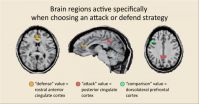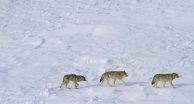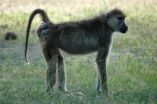The hereditary disorder, which appears in early childhood, had never been diagnosed as a single syndrome. The new research revealed that it is caused by mutations in a single gene that disrupt how proteins are shuttled around within cells. Patients with the newly discovered syndrome have a poor prognosis, and at present can only be treated with anti-inflammatory and immunosuppressant drugs. Many have lung disease so severe that they must receive lung transplants.
Thanks to biological mechanisms revealed in the research, patients could soon have access to a wider range of therapies, according to Anthony K. Shum, MD, UCSF assistant professor of medicine and co-senior author of the new study. "We believe that there are small molecules in development that can help correctly traffic the proteins that are misdirected in this syndrome, so that's something we really want to go after."
Levi B. Watkin, PhD, a postdoctoral fellow at Baylor, former UCSF postdoctoral fellow Birthe Jessen, PhD, and Wojciech Wiszniewski, MD, assistant professor of molecular and human genetics at Baylor, led the research, which is reported in the April 20, 2015 online edition of Nature Genetics.
For Shum, the project was sparked when a woman was admitted to the Emergency Department at UCSF Medical Center with pulmonary hemorrhage. In the course of treating the patient, Shum learned that she had arthritis as well, and that a sibling and aunt also had both lung disease and arthritis.
Some time later, when Shum encountered the patient's mother in the hospital corridor, she mentioned that a distant cousin she had never met had posted on a social media site that her own two-and-a-half-year-old daughter was being treated at a nearby hospital for pulmonary hemorrhage. Shum went to that hospital and found that, in addition to dramatic hemorrhaging in the child's lungs, she too had arthritis.
With the help of UCSF medical students, Shum began searching for other affected family members and ultimately identified a distant relative in another state with the same syndrome. The group then sequenced DNA samples from nine family members, some with the syndrome and some who are unaffected, to search for mutations that might underlie the disorder. "We sort of took a flyer," Shum said. "The likelihood of finding something was low."
UCSF scientists quickly zeroed in on a region of the genome containing a gene known as COPA, a result in which they initially had little confidence. "COPA mutations were completely unexpected," Shum said. "The COPA protein is expressed throughout the body, and no diseases associated with this gene had ever been reported." But an independent genetic analysis produced the same result: using this second method, Shum said, "You'll usually see peaks spread across the genome, but we only got a single peak. It was highly significant, and COPA was right under it."
The COPA protein is essential in intracellular transport - the process by which newly made proteins are moved to their proper locations in the cell - and the scientists found that the COPA mutations seen in the patients "cripple the protein," said Shum, preventing it from performing this vital function.
Encouraged by the consistency and clarity of these results, Shum reached out to physicians at other institutions to see if they had seen patients with the same cluster of symptoms.
"By pure serendipity," Shum said, he was soon contacted by co-senior author Jordan S. Orange, MD, PhD, director of the Texas Children's Hospital Center for Human Immunobiology, who had seen similar cases. Moreover, Orange's colleague, sequencing expert James R. Lupski, MD, PhD, co-senior author and Cullen Professor of Molecular and Human Genetics at Baylor, had independently fingered COPA mutations in his own genomic analyses of these cases.
Ultimately the UCSF-Baylor-Texas Children's team identified five families in which 30 family members carried deleterious COPA mutations. Only 21 of those carriers were affected by lung and joint problems, suggesting that, although the disease is inherited, it has "incomplete penetrance" - the presence of COPA mutations does not solely determine that an individual will develop the syndrome.
"The fact that we discovered five unrelated families and over 20 affected individuals in just over two and half years of investigating this leads me to believe that this is by no means ultra-rare," said Orange.
Subsequent experiments with tissue from affected patients revealed that faulty protein trafficking by mutant COPA results in a condition known as "cellular stress," which in turn sets off an autoimmune reaction mediated by immune-system cells known at Th17 cells.
Because Th17 cells have already implicated in autoimmune diseases, particularly in rheumatoid arthritis, Shum believes that targeting these cells with drugs may provide a new therapeutic avenue for those with the syndrome. "In our current research we're making sure that we have a clear mechanism, so we can come up with a potential drug target," he said.
Orange added that the new research may have ramifications that extend beyond this particular syndrome, especially for arthritis therapies. "We are excited to learn how variants of this disease might be more broadly applicable and might be instructive to our overall understanding of arthritis," he said.
In the meantime, Shum said, patients and their families have been gratified that the mysterious condition affecting their families is beginning to be understood. "When I first contacted the families we located, it was a huge relief to them to know that there are other people like them and that someone is working on this disorder."
INFORMATION:
The research was funded by the National Institutes of Health, The Jeffrey Modell Foundation, The Foundation of the American Thoracic Society, The Pulmonary Fibrosis Foundation, and The Nina Ireland Program for Lung Health at UCSF.
UCSF is the nation's leading university exclusively focused on health. Now celebrating the 150th anniversary of its founding as a medical college, UCSF is dedicated to transforming health worldwide through advanced biomedical research, graduate-level education in the life sciences and health professions, and excellence in patient care. It includes top-ranked graduate schools of dentistry, medicine, nursing and pharmacy; a graduate division with world-renowned programs in the biological sciences, a preeminent biomedical research enterprise and top-tier hospitals, UCSF Medical Center and UCSF Benioff Children's Hospitals. Please visit http://www.ucsf.edu.



